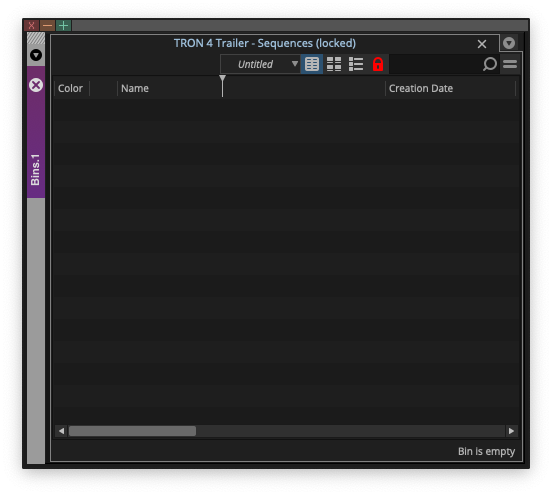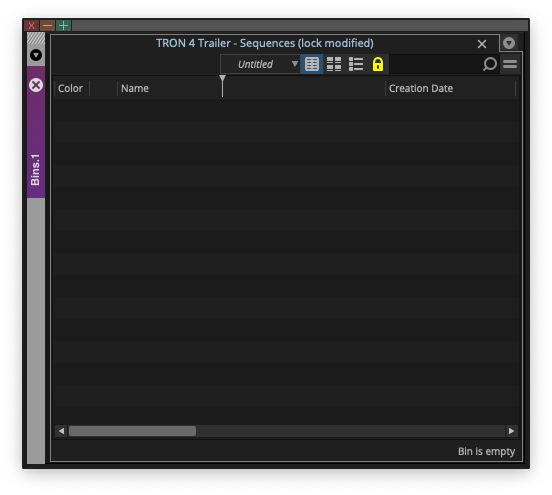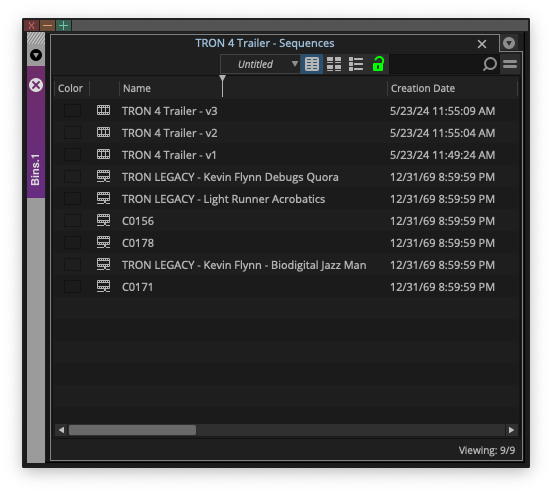A refreshing take for Mimiq

One and a half years after bringing Mimiq into the fold, we're proud to release what has been our goal with that acquisition since day 1: full parity with NEXIS workflows.
With today's 24.2 release, we fully close the gap between NEXIS and third-party storage workflows, by bringing you Bin Refresh and for Mimiq Pro the ability to use it simultaneously along side the NEXIS client.
Ecosystems
The Avid ecosystem is an interesting environment. Since Avid came up with Bin Locking, it’s been a staple of collaboration. In 2017, Avid upped the ante with Bin Refresh. Bin Refresh is bin locking taken to the next level — when you're accessing a locked bin, Bin Refresh allows you to see when changes are available and load them.

When changes are available, instead of a red lock icon you'll see a yellow lock.

That's not all: when the person who locked the bin closes it, the lock icon turns blue. Bin Refresh will now allow you to take ownership of that bin so that you can add changes. All of this without having to close and reopen a bin or even Media Composer 🤩

Although launched in Media Composer 8 in 2017, up until now Bin Refresh has been only available to NEXIS owners. Now, it's available to all Mimiq users that are on Media Composer 2020 and newer, and to both Pro and non-Pro licenses. If your license was purchased or extended more than 12 months ago, extend it online and then update in-app.

Local, Hybrid, and Remote
Now that non-NEXIS teams have full parity on Media Composer's collaboration tools, let's bring Mimiq's storage independence to NEXIS facilities.
Until today, using a third-party NAS or cloud storage like LucidLink meant not being able to use your NEXIS at the same time. That also meant having to copy all the media from one to the other for Media Composer to work as intended.
If a production required more or faster storage you either bought more Avid, or needed to bite the bullet and abandon your precious and expensive NEXIS installation altogether to replace it with a different NAS vendor.
With this release, we bridge that workflow gap: meet NEXIS Coexistence.
NEXIS Coexistence allows you to simultaneously use any type of storage together with a NEXIS. You can use a NEXIS with a QNAP for instance, or go hybrid by adding LucidLink to the mix, or both - all at the same time. Put your bins on one, media on the other. Put your DNxHD on a slow NAS, and DNxHR on a fast one. The sky's the limit; Avid productions no longer have to adapt to the hardware at hand. Expand and extend your storage anyway you like, anytime you need it.
Parisian Nights
To illustrate how big of a workflow change NEXIS Coexistence represents, here's a real life example:
Jax Media's Emily in Paris S02 was shot and edited during the COVID years, with teams in Paris, LA, and NY. Jax Media has a NEXIS in both US locations, and understandably wanted to make use of that infrastructure. The Parisian team used LucidLink with Mimiq Pro, uploading media and working directly from the cloud. The NY and LA teams then synced all that media to their NEXIS’ before being able to work with it, through a Mac that connected to both LucidLink and the NEXIS workspaces. Thankfully, the time zone shift allowed for syncing overnight, but having to use thrice the amount of storage is never fun from a budget perspective. Also, the syncing Mac was a potential single point of failure.
There was also a workflow challenge around the bins themselves: without NEXIS Coexistence, Media Composer can only "see" one type of storage. A bin on LucidLink can not be used together with media on NEXIS, at least not without losing bin locking capabilities. One envisioned stopgap solution to this was to sync bins between three locations too, and to sync just the lock files between two NEXIS’ and LucidLink. Another considered solution was to use LucidLink for all the bins, and connect to NEXIS over SMB instead of using the NEXIS client, but that's also not ideal.
With NEXIS Coexistence, this workflow simply works out of the box — no workarounds needed. Bins can stay on LucidLink, media be synced to on-prem, and if the sync has not caught up there's always the cloud drive fallback available. Vice versa, when there's a connectivity issue or cloud storage outage, on-prem work doesn't suffer. Happy faces, everywhere.
Teams should be able to use any type of storage at any time, for any production. Having an unused NEXIS accumulating dust just because it doesn't play nicely with other gear is a waste of money, and not sustainable. It's what could have kept Jax Media from having to go back to a fully on-prem production. Imagine the loss of talent by not being able to hire worldwide but only locally?
NEXIS Coexistence is available to all Mimiq Pro licenses that are within support. Not sure about yours? Check your license's status in our online License Manager.
Interoperability
With Avid being acquired last year, the first changes are becoming visible. Last year's 23.12 release laid the groundwork for a feature that's very promising; with Avid adding beta support for OpenTimeLineIO export on Windows, a clear signal has been given that other vendors should work towards a future where all NLEs and other creative apps play nice with each other.
OpenTimeLineIO ("OTIO") makes it possible to move, you guessed it, timeline data from one app to another. Instead of juggling with different versions of XMLs, EDL, ALEs, AAFs, OMFs, or whatever format, OTIO offers a single interconnecting format, and it's up to the NLE vendors to make sure their app implements it well. This is opposite from what is today's reality, where the engineering team of NLE A has an opinion as engineers are wont to do, and create a standard. However, NLE B's team has a different opinion, and thus now we have two standards that don't work together.
As OTIO is a standard driven by The Academy, it's not owned by vendors - it's owned by the end users. It's up to software vendors to play nicely, and they bloody well should. No one benefits from not being able to work without friction, and as many NLEs have seen it's very much a reason for abandoning a platform. As OTIO is easy to adopt, and cloud editing platforms are already doing so en masse, let's hope the Big Four put a bit of weight behind it too 🤞
